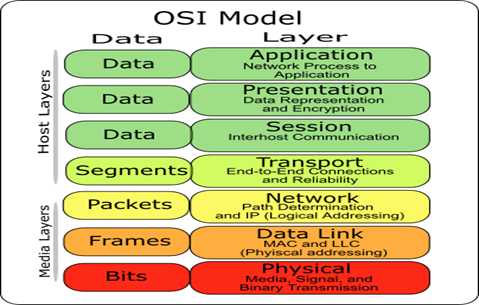Here we will see all different kind of Layer mechanism (OSI,DoD TCP/IP,Cisco Layers)
- OSI means Open System Interconnect Model
-Developed by IOS( International organization for standardization) in 1974
Now have closer look to OSI layer and method of remembering it very easily , please note here we will try only easy method of remembering all stuff out here.As no one have so long memory so I developed my easy methods hope it will help you out more.
Here 1st three layer is also known as SOFTWARE LAYER or UPPER LAYER( APPLICATION,PRESENTATION,SESSION) Where 2ed part means NETWORK,DATALINK PHYSICAL layer come in HARDWARE LAYER or LOWER LAYER.Where Transport layer is heart of OSI layer.
ok here is method to remember it.
1st method is
PLEASE DO NOT THROW SEXY PIZZA AWAY.......sound funny ha?
ok here is explanation
Please = physical Layer
Do = Data link Layer
Not = network Layer
throw = Transport Layer
Sexy =Session Layer
pizza = presentation Layer
Away = application layer
This I Called a reverse method from down to up.............
Ok now lets have look at another method.( thanks to altergothen)
All People Seem To Need Data Processing
Application ,Presentation ,Session ,Transport ,Network ,Data link ,Physical
See how easy to remember it?
ok now lets have look at which layer do what
| Layer | Responsible for | Task / Example | TYPE |
| Application Layer (Layer-7) |
|
| Data |
| Presentation Layer (Layer-6) |
|
| Data |
| Session Layer (Layer 5) (Connection) |
|
| Data |
| Transport Layer (Layer 4) (Segment) |
|
| Segment |
| Network Layer (Layer-3) |
|
| Packet |
| Data Link Layer (Layer-2) |
|
| Frame |
| Physical Layer (Layer-1) |
|
| Bits |
Easy Right? ok Here is some of note which one is very very important to remember
Note.1: Error Detection : Data Link Layer (Layer 2)
Error Correction : Transport Layer( Layer 4)
Note.2: Flow Control - congestion Avoidance,Windowing,Buffering.
Ok now lets compare TCP and UDP
| TCP | UDP |
|
|
|
|
* Very important to remember for your CCNA exam
*Note : DNS is the only service which work on TCP and UDP with same port no.
Now Lets have look at DoD( Department of Defense) TCP/IP model
| Layer | Protocol |
| Application Layer | Telnet,FTP,TFTP,LPD,SNMP,SMTP,NFS,X-WINDOW |
| Transport Layer | TCP UDP |
| Internet | ICMP,ARP,RARP,IP |
| Network | Ethernet,Fast Ethernet,Token Ring,FDDI |
Ok Now we are almost done Last but not least Comparison of Three model (OSI,DoD TCP/IP Model and Cisco Layer)
| OSI | DoD TCP/IP |
|
|
|
|
|
|
|
|
Cisco have 3 layers Core,Distribution,and Access Layer(We will learn more about this later )
Here is some good video about OSI layer if you wish to learn more.

No comments:
Post a Comment